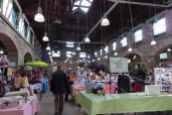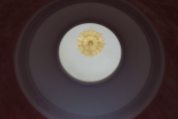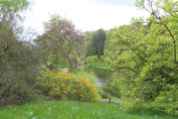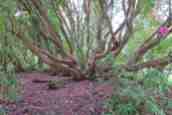The genealogy company MyHeritage recently announced it had refreshed the data for its ‘Theory of Family Relativity™’, a tool that computes hypothetical family relationships from historical records and DNA matches. It does this by ‘…incorporating genealogical information from [its] collections of nearly 10 billion historical records and family tree profiles, to offer theories on how you and your DNA Matches might be related.

In yesterday’s webinar I looked at a MyHeritage theory of the relationship between my husband Greg and his cousin Pearl. MyHeritage suggests that Pearl is Greg’s second cousin once removed. This is confirmed by the historical records. Greg and Pearl have well-developed and reliable family trees, so it wasn’t difficult to calculate the relationship.
It’s hard to say what’s new in MyHeritage’s new Theory. It’s possible that new ways of massaging the data have been developed, but it seems more likely that, with larger volumes of data being processed to develop Theories, ‘new’ simply means more, as in ‘newly-added’.
Anyway, I thought I’d give it a try.
MyHeritage’s announcement included a note advising users that ‘If we have found new theories for you in this update, you’ll see a banner about the Theory of Family Relativity™ at the top of your DNA Matches page. Click “View theories” to see all the theories we’ve found, both old and new.’
I couldn’t find this banner, but I eventually found my way to the filters on the DNA results page where by using the “All tree details” filter, I could select “Has Theory of Family Relativity™”

My husband Greg has 14 matches with theories. Back in March 2019 I counted 7 matches with theories so I looked at this list of matches again to see if I can learn anything new. In March 2019 Greg had 4313 DNA matches at MyHeritage. Now he has 6399, 50% more.
Several of the 14 matches in the list were matches I had not previously reviewed. I decided to look at S, whose DNA kit is managed by T from Canada.


Greg and S share 35 centimorgans across 1 segment. MyHeritage estimates them to be 3rd to 5th cousins. S appears in a family tree with 250 people. S is the 4th cousin of Greg according to the Theory of Family Relativity™. Ancestral surnames appearing in both trees include Dawe; Daw and Smith. Ancestral places common to Greg and S include Great Britain and Ireland.
I clicked on View Theory which I have highlighted with the green arrow.
There are three paths to support the theory that Greg and S are 4th cousins.
The first path uses 3 websites: my tree, a tree by B R from Australia and the third website the tree by T who administers the DNA kit for S. MyHeritage states “This path is based on 3 MyHeritage family trees, with 55% confidence”

The link is William Smith Dawe (1810-1977), Greg’s third great grandfather. I have on my tree that he is married to Mary Way (1811 – 1861). B R’s tree has William’s dates (1819 – 1877) and has William’s wife as Elizabeth Hocken 1821 – 1884 and the daughter of William and Elizabeth as Thirza Dawe 1824 – 1891. Thirza is the great great grandmother of S.
MyHeritage thinks the probability that the two William Smith Dawe’s on my tree and B R’s tree is 100% despite the differing birth dates. MyHeritage thinks the probability that Thirza Daw on B R’s tree is the same Thirza Daw on T’s tree is only 55%. I clicked on the small 55% immediately above the green letter b and got the following pop-up.

There are several problems with this first path of the theory calculated by MyHeritage. I don’t believe our William had two wives and Thirza born 1824 would have been born when William and Elizabeth were extremely young. I know this family does have common names and these are repeated across several generations. There are also several cousin marriages in this branch of the tree.
I looked at the second path to see if it is more plausible. MyHeritage states “This path is based on 4 MyHeritage family trees, with 70% confidence.”
The four trees are mine and the tree by T who administers the DNA kit for S plus a tree by JS from Australia and a tree by MT from Australia.

This path goes from Greg’s great grandmother Sarah Jane Way (1863 – 1898) to her mother Sarah Way née Daw (1837 – 1895). The Daw surname sometimes is spelt with an extra e as in the tree by J S. From Sarah Dawe on J S’s tree we go to Sarah Ellen Dawe (1837 – 1895) on the tree by M T. I am not sure where the middle name came from. I don’t recall it on any document. I will check the documents I have.
M T’s tree has the parents of Sarah Ellen Dawe as Betsey Metters 1792 – 1863 and Isaac Smith Dawe 1795 – 1851. From Isaac we link to T’s tree. He shows Isaac Smith Dawe 1797 – 1851 and Betsy Metters (Matters) 1792 – 1863 as the parents of Thirza Daw 1824 – 1891, the great grandmother of S.
This theory seems more plausible to me, but I need to verify this against source documents. At the links between the trees MyHeritage assigns a confidence level. Most of the links are 100% but MyHeritage is only 70% confident that Sarah Dawe in J S’s tree is the same person as Sarah Ellen Dawe in the tree by M T.
I clicked on the 70% and got the popup showing the comparison which gives additional detail from both trees. The difference is that the tree by J S has no parents has no parents but the tree by M T has Sarah Ellen Way’s parents as Isaac Smith Dawe and Betsy Metters. M T’s Sarah Ellen Daw has the same dates and places of birth and death as the Sarah Daw in my tree. I have plenty of documents to back up that sarah’s parents were not Isaac and Betsy but instead Isaac’s brother William Smith Daw.
This theory almost but not quite adds up. The need to go across several surnames is because of the spelling variations between Daw and Dawe. In my tree I have spelled the surname without a final ‘e’. I think MyHeritage has placed too much emphasis on the surname variation and not enough on other variations.
The third path “…is based on one community tree and 4 MyHeritage family trees, with 52% confidence”.

This path uses our tree, the tree by Greg’s cousin Pearl, a tree managed by S R from Great Britain, Family Search Family Tree, and the tree by T who administers the DNA kit for S.
Pearl’s tree provides the link between Sarah Daw on our tree spelt without an e to Sarah Dawe with an e and from there to her father William Dawe – surname with a final e. From there the link is to S R’s tree with William Smith Dawe (1810 – 1877), MyHeritage are only 72% confident they have the right man. William Dawe is not a direct forebear of Pearl and she has not provided many details for him in her tree.
S R shows Thirza Dawe (1824 – 1891) as the daughter of William Smith Dawe. From there the link is to FamilySearch Family Tree but with only 52% confidence. I clicked on the 53% to find out why MyHeritage is not confident they have the same person.
There are some important differences. The dates are the same and the place name variations are minor. FamilySearch, however, has Isaac Smith Dawe as the father of Thirza, not William Smith Dawe.
This path is rated 52% confidence by MyHeritage. The level of confidence is determined by its assessment of the weakest link.
I don’t think this path is correct. S R’s tree shows William Smith Dawe fathering Thirza when he was only 14, which is unlikely.
Of the three paths I think path 2 is most plausible but even then it is not quite right as it relies on the wrong father for Greg’s great great grandmother Sarah Way born Daw and does not fit with known records.
The next step is to review records and update my own tree using those records. After all, the Theory of Family Relativity generated by MyHeritage is meant to be a hint and not a proven conclusion.
I did not have Thirza Daw(e), the great great grandmother of S in my tree.
I have Isaac Smith Dawe (abt 1797 – 1851) and his wife Betsy Metters (1792 – 1863) in my tree. They show as Greg’s 4th great uncle. I have only one daughter showing for that marriage, the forebear of another match. Because Isaac is off to one side I have not researched all that family.
Isaac Daw appeared on the 1841 English census as a 40 year old miller living at Newton Mill, Tavistock, Devon. In the same household was Betsy Daw aged 45, and four children Betsy Daw aged 15, Honor aged 9, Jane aged 8, David aged 4.
On the 1851 census Isaac S Daw is a 54 year old miller employing 4 men and 1 boy living at Lumburn, Tavitock. In the same household are his wife Betsy aged 58, a niece aged 15 and a servant, a miller’s labourer, aged 30. All children have left home.
At the time of the 1841 census there may have been other children who had already left home.
Research by another cousin Lorna Henderson which she shared to Wikitree showed “entry in Beer Ferris in Tavistock parish register for 25 Aug 1818 shows Isaac Smith Dawe as sojourner of this parish, and Betsey Metters of this parish spinster, “married in this church by banns with the consent of their parents” by Harry Hobart, Rector. Both signed: Isaac Smith Daw and Betsey Matters. Wit: Humphrey Roberts, Mary Box (neither of whom witnessed other marriages on the page)”. I navigated to the Wikitree entry from MyHeritage when I searched Isaac Smith Dawe (Daw)/Dawe in All Collections. MyHeritage has 13,676,346 results for Isaac Smith Dawe (Daw)/Daw – far too many, the problem with a common name – they would of course be reduced as one narrowed down the search parameters.
I have been in correspondence with Lorna Henderson before and I know she is a most conscientious researcher and that Isaac is her direct forebear. She has a website for her family history at http://LornaHen.com and the details she has researched about Isaac Smith Daw are at http://familytree.lornahen.com/p28.htm . Lorna records there that in his will of 1847, William Smith Daw mentions his daughters: “My Daughters Names are as follows Mary Cook Betsey Bennett, Thirza Daw, Honor Daw and Jane Daw” and also his sons “my too sons Isaac Daw and David Daw”.
I could not find a baptism record for Thirza Daw in the MyHeritage record collections. On Wikitree cousin Lorna recorded that Thirza Daw was baptised 5 APR 1824 Tavistock, Devon, England. I found an image of her baptism in 1825 at FindMyPast. She was the daughter of Isaac Smith and Betsy Daw. Their abode was Newton Mill and Isaac’s occupation was Miller. I have updated Wikitree with the slightly revised date.
I am confident that Thirza is the daughter of Isaac Smith Daw, Greg’s 4th great uncle. Thyrza Daw shows up on the 1841 census as a female servant in another household. She married in 1850.
I traced down to S through English and Canadian censuses and other records. I found that she was Greg’s 5th cousin. S and Greg share 4th great grandparents Isaac Daw(e) 1769 – 1840 and Sarah Daw née Smith 1774 – 1833. Greg is descended from William Smith Daw 1810 – 1877 and S is descended from his brother Isaac Smith Daw 1797 – 1851.
I will update my family tree at MyHeritage. The Theory of Family Relativity won’t update straight away but at least I know that the next time it updates it may use the opportunity to trace a more accurate path.
As mentioned above I feel the algorithms MyHeritage used placed too much emphasis on the variation between Daw and Dawe and not enough emphasis on the parents named in the trees though there was obviously some weighting for variations in parents.
Nothing has changed about the MyHeritage theories particularly that I can see although I had not noticed previous theories that I reviewed making use of the tree at FamilySearch.
The Theories of Family Relativity generated by MyHeritage are just that, theories or hints. But they did point me in the right direction to make the connection between S and Greg and build my tree a little further.














































